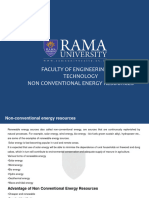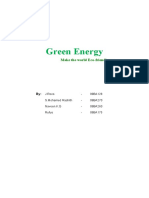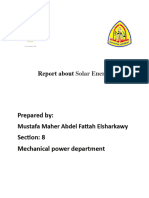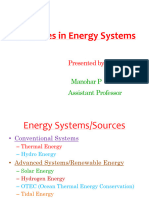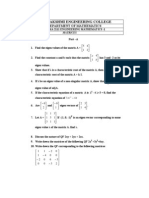Solar Energy: Virgin Islands Energy Office
Solar Energy: Virgin Islands Energy Office
Uploaded by
shibhiCopyright:
Available Formats
Solar Energy: Virgin Islands Energy Office
Solar Energy: Virgin Islands Energy Office
Uploaded by
shibhiOriginal Description:
Original Title
Copyright
Available Formats
Share this document
Did you find this document useful?
Is this content inappropriate?
Copyright:
Available Formats
Solar Energy: Virgin Islands Energy Office
Solar Energy: Virgin Islands Energy Office
Uploaded by
shibhiCopyright:
Available Formats
$E1ART3ENT O4 1LANN'NG AN$ NAT.RAL RESO.
R5ES
6'RG'N 'SLAN$S ENERGY O44'5E
70 ESTATE 3ARS 8'LL 4RE$ER'9STE$# 6'RG'N 'SLAN$S --+7TELE18ONE )7- ::);*-+< ST= > 4A= )7- ::<;--,) )7- ::7;))<- STT > 4A= )7- :*7;(0)*
!!!.vienergy.org
SOLAR ENERGY
INTRODUCTION: Solar energy is energy that comes from the sun. Every day the sun radiates an enormous amount of energy. The sun radiates more energy in one second than people have used since the eginning of time. All this energy comes from !ithin the sun itself. Li"e other stars# the sun is a ig gas all made up mostly of hydrogen and helium. The sun generates energy in its core in a process called nuclear fusion. $uring nuclear fusion# the sun%s e&tremely high pressure and hot temperature cause hydrogen atoms to come apart and their nuclei to fuse or com ine. Some matter is lost during nuclear fusion. The lost matter is emitted into space as radiant energy. 't ta"es millions of years for the energy in the sun%s core to ma"e its !ay to the solar surface# and then appro&imately eight minutes to travel the () million miles to earth. The solar energy travels to the earth at a speed of *+,#--- miles per second# the speed of light. Only a small portion of the energy radiated y the sun into space stri"es the earth# one part in t!o illion. Yet this amount of energy is enormous. Every day enough energy stri"es the .nited States to supply the nation%s energy needs for one and a half years/ A out *0 percent of the sun%s energy that hits the earth is reflected ac" into space. Another )- percent is used to evaporate !ater# !hich# lifted into the atmosphere# produces rainfall. 1lants# the land# and the oceans also a sor solar energy. The rest could e used to supply our needs. APPLICATIONS Photovoltaics: 1hotovoltaic are solar cells that produce electricity directly from sunlight. The solar cells are made of thin layers of material# usually silicon. The layers# after treatment !ith special compounds# have either too many or too fe! electrons. 2hen light stri"es a
sand!ich of the different layers# electrons start flo!ing and an electric current results. 1hotovoltaic are used throughout the nation and else!here to operate appliances# provide lighting# and to po!er navigation and communication aids. 1hotovoltaic panels provide po!er for e?uipment in space ships and satellites. 16 cells supply po!er needed to operate many "inds of consumer products such as calculators and !atches. 1hotovoltaic systems provide electricity to remote villages# residences# medical centers# and other isolated sites !here the cost of photovoltaic e?uipment is less than the e&pense of e&tending utility po!er lines or using diesel;generated electricity. Solar Thermal: Solar Thermal po!er is heat energy o tained y e&posing a collecting device to the rays of the sun. A solar thermal system ma"es use of the !armth a sor ed y the collector to heat !ater or another !or"ing fluid# or to ma"e steam. 8ot !ater is used in homes or commercial uildings and for industrial processes. Steam is used for process heat or for operating a tur ine generator to produce electricity or industrial po!er. There are several asic "inds of solar thermal po!er systems including @flat plateA solar !ater heatersB concentrating collectors# such as central to!er receiversB and para olic trough and dish collectors. Flat plate solar water heaters 2ater flo!s through tu es that are attached to a lac" metal a sor er plate. The plate is enclosed in an insulated o& !ith a transparent !indo! to let in sunlight. The heated !ater is transferred to a tan" !here it is availa le for home# commercial or institutional use. Central tower receivers 'n order to produce steam and electricity !ith solar thermal energy# central receivers have a
field of trac"ing mirrors called heliostats to focus sunlight onto a single receiver mounted on a to!er. 2ater or other heat transfer fluid in the to!er is heated and used directly or converted into steam for electricity. Parabolic ishes or tro!"hs curved panels !hich follo! the direction of the sun%s rays and focus the sunlight onto receivers. A li?uid inside the pipes at the receivers% focal point a sor s the thermal energy. The thermal energy received can e converted to electricity at each unit or transported to a central point for conversion to electricity. Solar Stills: Solar stills are systems designed to filter or purify !ater. The num er of systems designed to filter !ater have increased dramatically in recent years. As !ater supplies have increased in salinity# have een contaminated# or have e&perienced periods of contamination# people have lost trust in their drin"ing !ater supply. 2ater filtration systems can e as simple as a filter for taste and odor to comple& systems to remove impurities and to&ins. Solar !ater distillation is one of the simplest and most effective methods of purifying !ater. Solar !ater distillation replicates the !ay nature purifies !ater. The sunCs energy heats !ater to the point of evaporation. As the !ater evaporates# purified !ater vapor rises# condensing on the glass surface for collection. This process removes impurities such as salts and heavy metals# as !ell as destroying micro iological organisms. The end result is !ater cleaner than the purest rain!ater. Solar energy is allo!ed into the collector to heat the !ater. The !ater evaporates only to condense on the underside of the glass. 2hen !ater evaporates# only the !ater vapor rises# leaving contaminants ehind. The gentle slope of the glass directs the condensate to a collection trough# !hich in turn delivers the !ater to the collection ottle.
Solar Crop Dryers:
.sing the sun to dry crops and grain is one of the oldest and most !idely used applications of solar energy. The simplest# and least e&pensive techni?ue is to allo! crops to dry naturally in the field# or to spread grain and fruit out in the sun after harvesting. The disadvantage of these methods is that the crops and grain are su Dect to damage y irds# rodents# !ind# and rain# and contamination y !ind lo!n dust and dirt. 3ore sophisticated solar dryers protect grain and fruit# reduce losses# dry faster and more uniformly# and produce a etter ?uality product than open air methods. The asic components of a solar dryer are an enclosure or shed# screened drying trays or rac"s# and a solar collector. 'n hot# arid climates the collector may not even e necessary. The southern side of the enclosure itself can e glaEed to allo! sunlight to dry the material. The collector can e as simple as a glaEed o& !ith a dar" colored interior to a sor the solar energy that heats air. The air heated in the solar collector moves# either y natural convection or forced y a fan# up through the material eing dried. The siEe of the collector and rate of airflo! depends on the amount of material eing dried# the moisture content of the material# the humidity in the air# and the average amount of solar radiation availa le during the drying season. There are a relatively small num er of large solar crop dryers in the .nited States. This is ecause the cost of the solar collector can e high# and drying rates are not as controlla le as they are !ith natural gas or propane po!ered dryers. .sing the collector at other times of the year# such as for heating farm uildings# may ma"e a solar dryer more cost;effective. 't is possi le to ma"e small# very lo! cost dryers out of simple materials. These systems can e useful for drying vegeta les and fruit for home use.
AD#ANTA$%S AND DISAD#ANTA$%S OF SOLAR %N%R$& Advantages: Solar energy ma"es use of resource that is readily availa le. a rene!a le natural
Solar po!er used y itself creates no car on dio&ide or other to&ic emissions. .se of solar thermal po!er to heat !ater or generate electricity !ill help reduce the Territory%s complete dependence on fossil fuels. Solar !ater heaters are an esta lished technology# readily availa le on the commercial mar"et# and simple enough to uild# install and maintain y yourself. The production of electricity y the photovoltaic process is ?uiet and produces no to&ic fumes. 16 cells generate direct;current electricity that can e stored in atteries and used in a !ide range of voltages depending on the configuration of the attery an". Although most electric appliances operate on alternating current# an increasing num er of appliances using direct current are no! availa le. 2here these are not practical# 16;generated direct current can e changed into alternating current y use of devices called inverters.
Disadvantages:
Solar thermal systems are not cost;effective in areas that have long periods of cloudy !eather or short daylight hours. The arrays of collecting devices for large systems cover e&tensive land areas. Solar thermal systems only !or" !ith sunshine and do not operate at night or in inclement !eather. Storage of hot !ater for domestic or commercial use is simple# using insulated tan"s# ut storage of fluids at the higher temperatures needed for electrical generation# or storage of electricity itself# needs further technical development. 1hotovoltaic;produced electricity is presently more e&pensive than po!er supplied y utilities. Fatteries need periodic maintenance and replacement. 8igh voltage direct;current electricity can pose safety haEards to inade?uately trained home operators or utility personnel.
ADDITIONAL R%SOURC%S 1hotovoltaic 1rogramG www'eren' oe'"ov(pv( www'nrel'"ov(ncpv( Solar Thermal 1rogramG www'eren' oe'"ov(ste( www'eren' oe'"ov(csp www'san ia'"ov(Renewable)%ner"*(solarther+al(nstt,'ht+l American Solar Energy SocietyG www'ases'or"(solar
You might also like
- One Direct Method Statement: Main Hazards Preventative MeasuresNo ratings yetOne Direct Method Statement: Main Hazards Preventative Measures4 pages
- Solar Energy, & Its Advantages & DisadvantagesNo ratings yetSolar Energy, & Its Advantages & Disadvantages3 pages
- Solar Energy and Its Applications: A Seminar Report OnNo ratings yetSolar Energy and Its Applications: A Seminar Report On7 pages
- Advancement of The Solar Air Conditioning System100% (1)Advancement of The Solar Air Conditioning System21 pages
- Application of Non-Conventional & Renewable Energy SourceNo ratings yetApplication of Non-Conventional & Renewable Energy Source15 pages
- C. SYED AALAM, Lecturer in Mechanical Engineering. Annamalai University. IndiaNo ratings yetC. SYED AALAM, Lecturer in Mechanical Engineering. Annamalai University. India13 pages
- Water Purification Using Thermal MethodNo ratings yetWater Purification Using Thermal Method58 pages
- Solar Energy: The Ultimate Renewable Resource: Submitted by Ravi Verma 152118101No ratings yetSolar Energy: The Ultimate Renewable Resource: Submitted by Ravi Verma 15211810130 pages
- Non Conventional Energy Sources Focus On Solar EnergyNo ratings yetNon Conventional Energy Sources Focus On Solar Energy24 pages
- DIY Solar Projects - How To Put The Sun To Work in Your Home100% (2)DIY Solar Projects - How To Put The Sun To Work in Your Home297 pages
- Solar (Photovoltaic) System PresentationNo ratings yetSolar (Photovoltaic) System Presentation39 pages
- Non Conventional Energy Sources Focus On Solar Energy86% (14)Non Conventional Energy Sources Focus On Solar Energy23 pages
- JNTUA Renewable Energy Systems Notes - R20No ratings yetJNTUA Renewable Energy Systems Notes - R2030 pages
- Adigrat Universty Colleg of Engineering Technology Department of Mechanical Engineering Parabolic Trouph Solar Water Heater For Almeda TextailNo ratings yetAdigrat Universty Colleg of Engineering Technology Department of Mechanical Engineering Parabolic Trouph Solar Water Heater For Almeda Textail10 pages
- Advances in Solar Based Power GenerationNo ratings yetAdvances in Solar Based Power Generation27 pages
- Hybrid Power Generation Using Solar, Wind and Hydel and Designing of High Efficient InverterNo ratings yetHybrid Power Generation Using Solar, Wind and Hydel and Designing of High Efficient Inverter3 pages
- Experimental Verification and Analysis of Solar Parabolic Collector For Water DistillationNo ratings yetExperimental Verification and Analysis of Solar Parabolic Collector For Water Distillation6 pages
- Harvesting Solar, Wind and Tidal Power - Environment for Kids | Children's Earth Sciences BooksFrom EverandHarvesting Solar, Wind and Tidal Power - Environment for Kids | Children's Earth Sciences BooksNo ratings yet
- How to Install & Design Solar Panels Like a ProfessionalFrom EverandHow to Install & Design Solar Panels Like a ProfessionalNo ratings yet
- Basic Off-grid & On-grid Design Solar Systems from Scratch: Bonus: Guide to Project Design in Autodesk© Autocad©.From EverandBasic Off-grid & On-grid Design Solar Systems from Scratch: Bonus: Guide to Project Design in Autodesk© Autocad©.5/5 (1)
- Basher Science Mini: Green Technology: The Ultimate Cleanup Act!From EverandBasher Science Mini: Green Technology: The Ultimate Cleanup Act!No ratings yet
- Renewable Energy Sources - Wind, Solar and Hydro Energy Edition : Environment Books for Kids | Children's Environment BooksFrom EverandRenewable Energy Sources - Wind, Solar and Hydro Energy Edition : Environment Books for Kids | Children's Environment BooksNo ratings yet
- Solar Panel Improvement: 1950–2016: For Solar, by Solar, to SolarFrom EverandSolar Panel Improvement: 1950–2016: For Solar, by Solar, to SolarNo ratings yet
- His Excellency Mahinda Rajapaksa: Address byNo ratings yetHis Excellency Mahinda Rajapaksa: Address by5 pages
- Surgeon-General Charles Sibthorpe: Harriet Wheelock May 2011No ratings yetSurgeon-General Charles Sibthorpe: Harriet Wheelock May 20116 pages
- California Standards Test Biology/Life ScienceNo ratings yetCalifornia Standards Test Biology/Life Science8 pages
- June 21, 2002 Twentieth Meeting Presidential Advisory Council On HIV/AIDS Louis Sullivan, MD, Co-Chair Tom Coburn, MD, Co-Chair Washington, DCNo ratings yetJune 21, 2002 Twentieth Meeting Presidential Advisory Council On HIV/AIDS Louis Sullivan, MD, Co-Chair Tom Coburn, MD, Co-Chair Washington, DC2 pages
- Presentation Orale h31b 1158 Salif-Kone Agu Dec 2013No ratings yetPresentation Orale h31b 1158 Salif-Kone Agu Dec 201316 pages
- Sample Research and Template Environmental Managment 1No ratings yetSample Research and Template Environmental Managment 161 pages
- St. Louis College of Bulanao: Purok 6, Bulanao, Tabuk City, Kalinga 3800No ratings yetSt. Louis College of Bulanao: Purok 6, Bulanao, Tabuk City, Kalinga 38008 pages
- Structuring - Problems - For - Multi - Criteria - Decision - Analysis SWOT-MCDANo ratings yetStructuring - Problems - For - Multi - Criteria - Decision - Analysis SWOT-MCDA41 pages
- Life Cycle Cost Modelling and Economic Analysis of Wind Power: A State of Art ReviewNo ratings yetLife Cycle Cost Modelling and Economic Analysis of Wind Power: A State of Art Review23 pages
- Project Proposal Outline Form For CWTS02&03No ratings yetProject Proposal Outline Form For CWTS02&034 pages
- ASHRAE 2019 Handbook - HVAC Applications (SI) Chapter 34 Kitchen Ventilation100% (1)ASHRAE 2019 Handbook - HVAC Applications (SI) Chapter 34 Kitchen Ventilation46 pages
- Waste Handling Management 2022 Scheme Vtu Notes Bme306dNo ratings yetWaste Handling Management 2022 Scheme Vtu Notes Bme306d150 pages
- 얇빠 미니모의 수능독해 실전 고난도 일치,유추 (영문) 01회 50문제 sampleNo ratings yet얇빠 미니모의 수능독해 실전 고난도 일치,유추 (영문) 01회 50문제 sample17 pages
- Biodiversity in Natural Versus Managed Forest in Denmark: Cite This PaperNo ratings yetBiodiversity in Natural Versus Managed Forest in Denmark: Cite This Paper6 pages
- Chronology of Methane Poisoning in Pasir GudangNo ratings yetChronology of Methane Poisoning in Pasir Gudang4 pages
- Chapter-3 River Diversion Works and ComponentsNo ratings yetChapter-3 River Diversion Works and Components9 pages
- EPRS - ATA (2022) 738177 - EN Corporate Sustainability Reporting DirectiveNo ratings yetEPRS - ATA (2022) 738177 - EN Corporate Sustainability Reporting Directive1 page
- One Direct Method Statement: Main Hazards Preventative MeasuresOne Direct Method Statement: Main Hazards Preventative Measures
- Solar Energy and Its Applications: A Seminar Report OnSolar Energy and Its Applications: A Seminar Report On
- Application of Non-Conventional & Renewable Energy SourceApplication of Non-Conventional & Renewable Energy Source
- C. SYED AALAM, Lecturer in Mechanical Engineering. Annamalai University. IndiaC. SYED AALAM, Lecturer in Mechanical Engineering. Annamalai University. India
- Solar Energy: The Ultimate Renewable Resource: Submitted by Ravi Verma 152118101Solar Energy: The Ultimate Renewable Resource: Submitted by Ravi Verma 152118101
- Non Conventional Energy Sources Focus On Solar EnergyNon Conventional Energy Sources Focus On Solar Energy
- DIY Solar Projects - How To Put The Sun To Work in Your HomeDIY Solar Projects - How To Put The Sun To Work in Your Home
- Non Conventional Energy Sources Focus On Solar EnergyNon Conventional Energy Sources Focus On Solar Energy
- Adigrat Universty Colleg of Engineering Technology Department of Mechanical Engineering Parabolic Trouph Solar Water Heater For Almeda TextailAdigrat Universty Colleg of Engineering Technology Department of Mechanical Engineering Parabolic Trouph Solar Water Heater For Almeda Textail
- Hybrid Power Generation Using Solar, Wind and Hydel and Designing of High Efficient InverterHybrid Power Generation Using Solar, Wind and Hydel and Designing of High Efficient Inverter
- Experimental Verification and Analysis of Solar Parabolic Collector For Water DistillationExperimental Verification and Analysis of Solar Parabolic Collector For Water Distillation
- Harvesting Solar, Wind and Tidal Power - Environment for Kids | Children's Earth Sciences BooksFrom EverandHarvesting Solar, Wind and Tidal Power - Environment for Kids | Children's Earth Sciences Books
- Renewable Energy: You Can Make A Difference Too!From EverandRenewable Energy: You Can Make A Difference Too!
- How to Install & Design Solar Panels Like a ProfessionalFrom EverandHow to Install & Design Solar Panels Like a Professional
- Basic Off-grid & On-grid Design Solar Systems from Scratch: Bonus: Guide to Project Design in Autodesk© Autocad©.From EverandBasic Off-grid & On-grid Design Solar Systems from Scratch: Bonus: Guide to Project Design in Autodesk© Autocad©.
- Basher Science Mini: Green Technology: The Ultimate Cleanup Act!From EverandBasher Science Mini: Green Technology: The Ultimate Cleanup Act!
- Renewable Energy Sources - Wind, Solar and Hydro Energy Edition : Environment Books for Kids | Children's Environment BooksFrom EverandRenewable Energy Sources - Wind, Solar and Hydro Energy Edition : Environment Books for Kids | Children's Environment Books
- Solar Panel Improvement: 1950–2016: For Solar, by Solar, to SolarFrom EverandSolar Panel Improvement: 1950–2016: For Solar, by Solar, to Solar
- Surgeon-General Charles Sibthorpe: Harriet Wheelock May 2011Surgeon-General Charles Sibthorpe: Harriet Wheelock May 2011
- June 21, 2002 Twentieth Meeting Presidential Advisory Council On HIV/AIDS Louis Sullivan, MD, Co-Chair Tom Coburn, MD, Co-Chair Washington, DCJune 21, 2002 Twentieth Meeting Presidential Advisory Council On HIV/AIDS Louis Sullivan, MD, Co-Chair Tom Coburn, MD, Co-Chair Washington, DC
- Presentation Orale h31b 1158 Salif-Kone Agu Dec 2013Presentation Orale h31b 1158 Salif-Kone Agu Dec 2013
- Sample Research and Template Environmental Managment 1Sample Research and Template Environmental Managment 1
- St. Louis College of Bulanao: Purok 6, Bulanao, Tabuk City, Kalinga 3800St. Louis College of Bulanao: Purok 6, Bulanao, Tabuk City, Kalinga 3800
- Structuring - Problems - For - Multi - Criteria - Decision - Analysis SWOT-MCDAStructuring - Problems - For - Multi - Criteria - Decision - Analysis SWOT-MCDA
- Life Cycle Cost Modelling and Economic Analysis of Wind Power: A State of Art ReviewLife Cycle Cost Modelling and Economic Analysis of Wind Power: A State of Art Review
- ASHRAE 2019 Handbook - HVAC Applications (SI) Chapter 34 Kitchen VentilationASHRAE 2019 Handbook - HVAC Applications (SI) Chapter 34 Kitchen Ventilation
- Waste Handling Management 2022 Scheme Vtu Notes Bme306dWaste Handling Management 2022 Scheme Vtu Notes Bme306d
- Biodiversity in Natural Versus Managed Forest in Denmark: Cite This PaperBiodiversity in Natural Versus Managed Forest in Denmark: Cite This Paper
- EPRS - ATA (2022) 738177 - EN Corporate Sustainability Reporting DirectiveEPRS - ATA (2022) 738177 - EN Corporate Sustainability Reporting Directive















